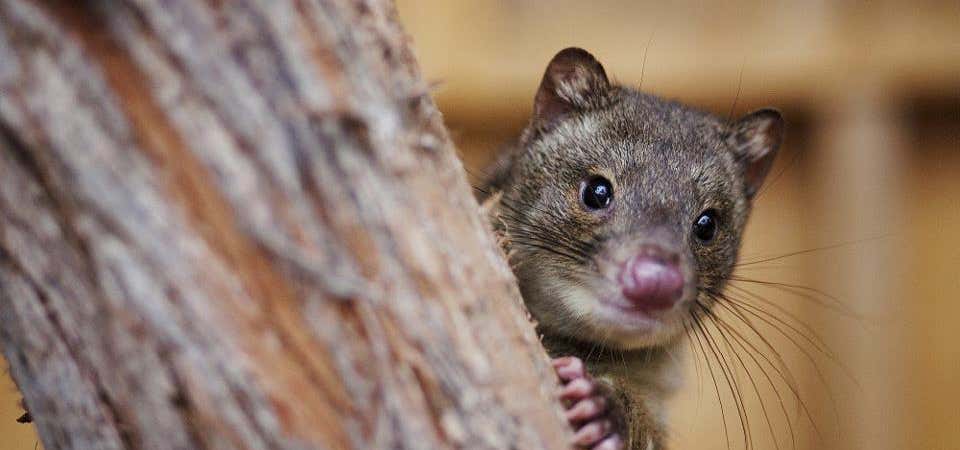A trip around Victoria, including the scenic coastal drive of the Great Ocean Road, could almost be described as one giant wildlife park. Australia’s second smallest state punches above its weight when it comes to native wildlife.
Expect to see a view with a ‘roo or two, as well as wallabies, emus, echidnas, platypus and more. The marine life spotted from coastal Victoria is a true highlight, particularly the breaching southern right whales and the little penguins on Phillip Island.
Maximise your Victoria explore our top wildlife hot spots.
An exploration of the Otway Ranges reveals ancient plant life, colossal trees, imposing waterfalls, and more native fauna than your bucket list even knew it needed. There are so many opportunities to encounter new furry and feathered friends, all in their natural habitat. From kangaroos, to wallabies, echidnas, cockatoos, galahs and the giggling kookaburras.
Although koalas can be seen across the Otways, Cape Otway is where most gather. Take the time to visit the Cape Otway Centre for Conservation and you can join a guided tour to observe the many creatures who call this area home.
And be sure not to miss Melba Gully for twinkly glowworm spotting!


"Melba Gully Glow Worm Caves" — Photo Credit: I Am Otways
However, if Australia’s animal anomaly, the platypus, is on your wishlist, Lake Elizabeth is the spot to visit. But please be aware, this is only for the patient. Look for ripples on the water’s surface or to up your platypus-spotting odds to 95%, book a Paddle with the Platypus canoe tour with Eco Certified Otway Eco.
Raymond Island
There was a period in the 1920s when Victoria was devastatingly almost koala-free due to fire, voracious disease, clearing and the fur trade wiping them out. Thanks to 1953 rehabilitation efforts, the koala has made a comeback and Raymond Island is the place to go.
This quiet isle, 300km from Melbourne, is a haven to koalas, echidnas, and kangaroos, with sightings practically guaranteed. The aptly named Koala Trail is a breeze to walk at 1.4 kilometres, but take your time as all the (sleepy) action is above you.
Reach Raymond Island on the short (and free for pedestrians) ferry ride from Paynesville.
If there is only one place you decide to go wildlife watching in Victoria, make it Phillip Island. Though it is celebrated for its penguin colony, Phillip Island offers a plethora of wildlife experiences, including the Koala Conservation Centre. Essential in saving the islands koala population, the Koala Conservation Centre has both a breeding and a natural bush conservation programme. The unique tree top boardwalk system allows visitors to see how amazing these curious little fur balls are, as well as being treated to glorious views of the the wetlands. From up high you get to see koalas go about their lives as well as super cute photo opportunities of joeys piggy backed by their mothers, learning all of the tricks of the koala trade - from climbing, to foraging for food and meeting new koala pals.
Better still join a ranger on a “Koala Eco-Explorer Tour” to learn all about Aussie’s sleepy icon.
Phillip Island Nature Parks
The world’s smallest penguins call Phillip Island their home, comically waddling from to the dunes at sunset. The not-for-profit Phillip Island Nature Park offers self-guided viewing or ranger-led tours for the Penguin Parade. Viewing options include a ranger commentary from the viewing platform, an eye level viewing option (limited to just 70 people) from the underground viewing window, or a couple of VIP tours where, led by a ranger you can see them from the elevated platform, or better still don night vision gear and headphones and set off for a secluded beach for a very intimate evening with the little penguins.
For marine life, head to the delightful little settlement of Seal Rocks to spy the playful seals. Bird lovers should head to Rhyll Inlet where migratory wading birds come to feed and breed, including spoonbills, herons, and cormorants.


"Seal Rocks, Phillip Island" — Photo Credit: Visit Victoria


"Rhyll Inlet, Phillip Island" — Photo Credit: Visit Bass Coast
Healesville Sanctuary
One of the most popular places to see exclusively Australian animals is Healesville Sanctuary, in the heart of the Yarra Valley. This world-renowned bushland haven hosts all the regular Aussies animals and critters you would expect to see, but they also have a particular interest in birds of prey. The daily Spirits of the Sky show demonstrates the prowess of these magnificent birds, along with parrots showing their colourful plumes in the flight arena.
Whilst you’re there don’t miss the Australian Wildlife Health Centre, rehabilitating 1500 sick, injured or orphaned animals annually. And do make sure you track down the helmeted honeyeater; it’s the only endemic bird to Victoria.
While you’re only likely to see pigeons in central Melbourne, if you know where to go, there is access to fabulous wildlife just a few kilometres away.
A tram ride from the CBD, the Royal Melbourne Zoo is the country’s oldest. The Australian Bush section includes koalas, Tasmanian devils, wombats, kangaroos and more. Wander the boardwalk through the Great Flight Aviary and look out for the wedge-tailed eagle.
Another option is the Moonlit Sanctuary Wildlife Conservation Park which provides a bushland setting to over 200 Australian animals of 30 species. The lantern-lit evening tour is recommended for its great viewing of those nocturnal critters, but please remember to book as numbers are limited. You can see feathertail gliders dart around, endangered quolls, quirky pademelons, cheeky little Tasmanian devils and the curious kangaroo-rat like bettongs, all seeking out their dinner and carrying on like these Aussie critters do.
St Kilda Pier
And when in Melbourne, head to St Kilda’s Breakwater post-sunset to watch little penguins waddle ashore each night. Please be considerate to these little guys and don’t point selfie sticks into the penguin rock homes and please don’t take flash photographs as this can be very distressing to them and if you do take a torch, please cover it in red cellophane as penguins are less affected by the red spectrum of light and therefore will be much less upset. Finally, please be respectful of the nesting sites, as the little ones are very precious to their nesting parents.
Glamping in the Grampians - Halls Gap Lakeside Tourist Park
Rugged mountains and country plains make up the Grampians National Park, home for a broad range of native wildlife. Kangaroos, bandicoots, emus, and echidnas all call the park their home. In fact at Halls Gap - gateway to the Grampians - there are far more kangaroos than people who reside here. And bird lovers can rejoice at being surrounded by kookaburras, galahs, and endangered red-tailed black cockatoos.
Camping under the starry Grampians sky is recommended to really encounter Australian fauna, as so many of them are nocturnal. There are a range of accomodation options at Halls Gap Lakeside Tourist Park, from glamping bell tents, to retro caravans or even your very own fully functioning 737 flight simulator attached to your safari tent. Just ‘cause you can…
Did you know you can actually check ‘swimming with wild dolphins’ off your bucket list in the waters of Port Phillip Bay, just out of Melbourne?
From October to April, sign up for a dolphin swimming cruise where you’ll don a wetsuit and snorkel for some playtime with the bay’s 150 bottlenose dolphins. You’ll also head to the fur seals’ playground for a snorkel, as well exploring this protected home for copious colourful fish. Scuba diving is also an option, with shipwrecks in the area providing further adventures.
Wilsons Promontory National Park
Wilsons Promontory National Park, aka The Prom, is a state favourite and one of Victoria’s largest coastal wilderness areas. With beaches, bush and mountains, the scale and diversity of The Prom attracts a host of native Aussie animals.
Within the park, the Woodland Walk is one of the quieter areas to explore, with kangaroos, wallabies, wombats, emus, and echidnas crossing your path (if you’re lucky). Combine with a hike to Mt Bishop for stellar views, and don’t miss Squeaky Beach to test out its name.


"Woodlands Walk, Wilsons Promontory" — Photo Credit: Flickr - Eduardo M. C


"Squeaky Beach, Wilsons Promontory" — Photo Credit: Flickr - Parks Victoria
Tower Hill Wildlife Reserve
The 30,000-year-old extinct volcano at Tower Hill created an ecosystem for native animals to wander freely. In 1892, it was declared a national park and the Tower Hill Wildlife Reserve was born. Visiting Tower Hill is one of the biggest drawcards to Warrnambool.
Expect to see all iconic and exciting Australian fauna, including emus, koalas, kangaroos, reptiles, and fabulous birds. Try and time your visit for the 11am guided tour which combines wildlife know-how with aboriginal history of the area.
Logan Beach Whale Watching Platform
If you’re in Warrnambool from June to September, it’s worthwhile heading to the whale-watching platform to witness the majestic southern right whales breaching whilst on their annual migration.
Close to the VIC/NSW border is Mount Buffalo National Park. With picturesque mountains, alpine trails and an abundance of water activities, Mount Buffalo is an adventure playground offering hiking in summer and snow activities in winter.
Birdlife is plentiful here in the warmer months, especially larger ones like the currawong or lyrebird. The wedge-tailed eagle also calls Mount Buffalo home. With a wingspan of around 2m, they are easy to spot soaring overhead, though don’t mistake them for the kestrels or peregrine falcons seen here too!
During dawn and dusk you can spy wallabies, wombats, possums, the tawny frogmouth, and even sugar gliders flying overhead.
Explore More Trip Guides
Western Australia’s Wonderful Wildlife
- 9 Places
- 39:16
- 2,160 mi
Whales, Wonderous Whales. And where to see them Queensland.
- 7 Places
- 25:42
- 1,256 mi
Whales, Wonderous Whales. And where to see them NSW.
- 12 Places
- 18:15
- 926 mi
Queensland And Its Glorious Native Wildlife!
- 12 Places
- 26:35
- 1,344 mi

















